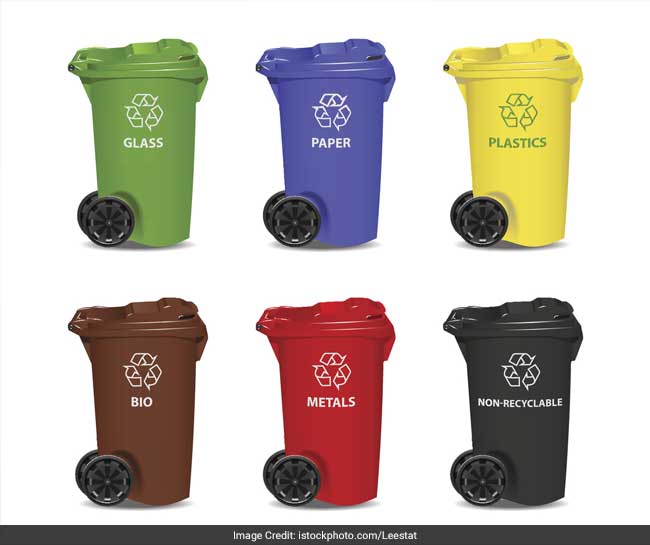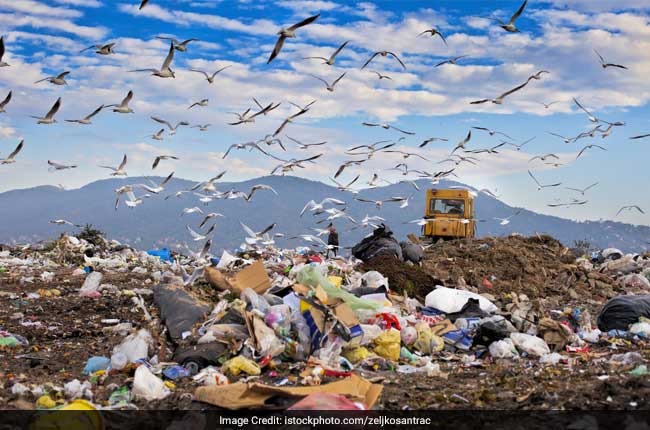Did you know that India, a country of 1.2 billion, is running the risk of drowning in all the waste it generates on a daily basis? At present, around 62 million tonnes of solid waste is generated annually out of which 5.6 million tonnes is plastic waste, 0.17 million tonnes is biomedical waste, hazardous waste generation is 7.90 million tonnes per annum and 15 lakh tonne is e-waste. India is among the top 10 countries in the world generating the highest amount of municipal solid waste, and the bigger problem is that approximately 70-75% of this waste remains untreated. This untreated waste of 31 million is mostly dumped into landfills.
Major Indian metros like Mumbai, Delhi, Bengaluru, Kolkata and Chennai generate about 10 million tonnes of garbage every day. Mumbai and Delhi have 3 major landfills each and their biggest/main landfills, Deonar in Mumbai (90 years old) and Ghazipur in Delhi (33 years old) are functioning way beyond their lifespan. To deal with this crisis, the Swachh Bharat Abhiyan launched by Prime Minister in 2014, has set specific targets. For instance, all waste generators should segregate their waste at source, municipal bodies should provide solutions for dealing with segregated waste and create effective Solid Waste Management plants. In 2016, the Union Ministry of Environment, Forests and Climate Change came up with the new Solid Waste Management Rules (SWM). These rules are the sixth category of waste management rules and do not include plastic, e-waste, biomedical, hazardous and construction and demolition waste. These were last updated 16 years ago by the ministry.
Also Read: Waste Management: How India Is Drowning In Garbage
As per these new rules ‘waste’ is defined as solid waste alone which is generated by all the households, hospitality industry, big and small market vendors. These rules are applicable beyond municipal areas and extend to urban agglomerations, census towns, notified industrial townships, areas under the control of Indian Railways, airports, airbase, port and harbour, defence establishments, special economic zones, State and Central government organizations, places of pilgrims, religious & historical importance.
10 Things That You Need To Know About Solid Waste Management Rules 2016
- Segregation Of Waste Is Important | As per the new rules, all waste generators should start segregating their waste into three categories – Biodegradables, Dry Waste (Plastic, Paper, metal, Wood) and Domestic Hazardous Waste (diapers, napkins, mosquito repellents, cleaning agents) before they hand it over to the collectors.
The institutional generators, market associations, event organisers and hotels and restaurants are made directly responsible for segregation and sorting their waste. They should manage the waste generated by them in partnership with the local bodies. In case there is an event, or gathering of more than 100 persons at any place, then the organiser will have to ensure segregation of waste is done at source. Local bodies or waste collectors will not be allowed to collect unsegregated waste from the place.
Coming to the hospitality industry, all hotels and restaurants under the new guidelines are required to segregate biodegradable waste and set up their own system of waste collection to ensure that food waste is utilised for composting / biomethanation. The rules also mandate that all resident welfare and market associations and gated communities with an area of above 5,000 square metre will have to segregate waste at source into material like plastic, tin, glass, paper and others and hand over recyclable material either to authorised waste-pickers and recyclers or to the urban local body.
- Collection And Disposal Of Sanitary Napkins | In order to manage the sanitary waste like diapers and sanitary pads effectively, the new guidelines have made it mandatory for the manufacturers to provide a pouch or wrapper for disposal whenever they sell their products to the customer.
The guidelines also mandate that waste generators need to ensure that they dispose of the sanitary waste in the pouches or wrapper provided by the manufacturers. In order to deal with growing sanitary waste, the new rules have made it mandatory for all the local authorities to set up a sanitary landfill in their area; the guidelines are as follows -For the population of 1 million or more, the time frame to set up a sanitary landfill is within two years. For census towns with a population below 1 million, stand-alone sanitary landfills will have to be set up within three years’ time. Also, common, or regional sanitary landfills will have to be set up by all local bodies and census towns with a population under 0.5 million within the timespan of three years. - Introduction Of New Things – User Fees And Spot Fines | Under the new rules, waste generators will have to pay some amount to the waste collectors for activities like collection, disposal, and processing of waste. The local body across India has the authority to decide the ‘User Fees.’The rules also stipulate zero tolerance for throwing, burning or burying the solid waste generated on streets, open public spaces, water bodies, etc. “Spot Fines” are also introduced under these new rules which means if someone is found littering or disobeying the guidelines, then local bodies have the authority to fine them.
- Collect Back System For Non-biodegradable Packaging Waste | The new guidelines says that the brand owners who sell or market their products in packaging material which are non‐biodegradable or are not environmental friendly, will have to put a system in place to collect back the packaging waste generated due to their production.
- A Bin Is A Must For Street Vendors | All street vendor should keep suitable containers or bins for storage of the waste generated by them such as food waste, disposable plates, cups, cans, wrappers, coconut shells, leftover food, vegetables, fruits etc. They are also responsible for their own waste and should deposit their waste at a waste storage depot or container or vehicle as notified by the local authority.
- Guidelines For The Over-growing Landfills | No non-recyclable waste having calorific value of 1500 K/cal/kg or more shall be disposed in the landfills. That waste can either be utilised for generating energy or can be used for preparing refuse derived fuel. It can also be used for co-processing in cement or thermal power plants. As per the new rules, the landfill site should be 100 metres away from a river, 200 metres from a pond, 500 metres away from highways, habitations, public parks and water supply wells and 20 km away from airports/airbase.
The new guidelines recommend that the construction of landfills on hills should be avoided. For the sanitary landfills, the land for construction will be identified in the plain areas, within 25 kilometers. However, the transfer stations and processing facilities will be operational in the hilly areas.
- Waste Processing And Treatment Guidelines | The new rules advise that the bio-degradable waste should be processed, treated and disposed of through composting or bio-methanation within the premises as far as possible and the residual waste shall be given to the waste collectors or agency as directed by the local authority. The developers of Special Economic Zone, industrial estate, industrial park will also have to earmark at least 5 percent of the total area of the plot or minimum 5 plots/ sheds for recovery and recycling facility.The rules have also mandated bio‐remediation or capping of old and abandoned dump sites within five years.
- Involvement of Ragpickers | The new rules help in the integration of ragpickers, waste pickers and kabadiwalas from the informal sector to the formal sector by the state government.
- Guidelines for Municipal authorities | All local bodies are required to set up few by-laws regarding waste management, segregation of waste within their society. They are also required to set up a system in place so as the process of waste segregation can be followed smoothly by all waste generators. They are also required to promote the idea of composting, waste segregation and waste management through different educative campaigns.
- The Process Of Monitoring | The government has also established a Central Monitoring Committee under the chairmanship of Secretary, MoEF&CC to monitor the overall implementation of the rules effectively. It is advised that the committee comprising of various stakeholders from the central and state governments will meet once a year to discuss and monitor the implementation of these rules.







 The new guidelines recommend that the construction of landfills on hills should be avoided. For the sanitary landfills, the land for construction will be identified in the plain areas, within 25 kilometers. However, the transfer stations and processing facilities will be operational in the hilly areas.
The new guidelines recommend that the construction of landfills on hills should be avoided. For the sanitary landfills, the land for construction will be identified in the plain areas, within 25 kilometers. However, the transfer stations and processing facilities will be operational in the hilly areas.




























wastenvironment
April 19, 2017 at 10:23 am
A comprehensive guide on the solid waste management rules 2016. You may also consider updating it with the material recycling facilities (MRF) inclusion in the rules.
Amardeepsharma
September 24, 2017 at 7:58 pm
Without completely procssing MSW/GARBAGE, ZERO LANDFILL TECHNOLOGY. We can not talk too much about SWACHH INDIA.
Nikita Yogi Ganatra
May 17, 2018 at 5:30 pm
There is so much that people don’t even know forget about implementing. Bringing awareness and taking small steps from each household is a must now.
Jaiyesukumar
August 13, 2018 at 1:42 pm
Solid waste management is the process by which solid wastes are segregated and recyclable wastes are recycled, and compostable wastes are composted to reuse. It is a process of managing the waste to recycle and reuse it. Sam Eco Radial Vision Environment employs a street beautifier with a Push Cart to collecting the waste. Sam Eco Radial Vision Environment involves Village Panchayat in solid waste management project as a part of environment concern. The project not only involves environment it also provides employment to people and the generated income can be used for the project management.
Neha singh सोशल वर्कर khushi foundation kanpur Uttar Pradesh
October 2, 2020 at 11:07 am
Blow is a very big problem of society today, people will have to go ahead and solve the problem by leaving it not only to the government but the officials of some government institutions who do not support non-government institutions They should support the institutions and to keep the society clean, with the cooperation of non-governmental institutions, they should be allowed to work in the society easily, otherwise the government alone how long the waste Continue to fight with the waste and some government officials will take full advantage of this opportunity and continue to harm the country financially, solutions will come to the non-governmental organizations and people will get the problems of the waste.People have to be made aware as well as teach them how to manage waste separately.
nikku
March 21, 2021 at 9:43 pm
thanks ndtv. u helped me to complete my project